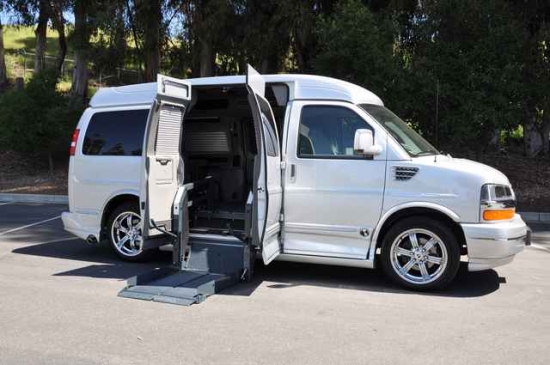Whether you’re considering a full-sized mobility van, or retrofitting your minivan to be handicap accessible, there are many options and considerations to keep in mind when looking for the right commercial wheelchair lift.
Before the invention of the commercial wheelchair lift, people with disabilities or their loved ones had to manually fold the wheelchair and put it in the trunk. This process was inconvenient, unsafe, time consuming and strenuous.
Thanks to modern wheelchair lift technology, individuals with disabilities are able to experience more independence, freedom and convenience. Each type of lift has its advantages and disadvantages.

Rotary Wheelchair Lifts
A rotary lift moves a wheelchair or scooter in and out of the vehicle via a “boom arm,” which can be powered electrically or hydraulically. The rotary lift is one of the cheapest wheelchair lift options for vans, but has a low lifting capacity and therefore cannot handle a lot of weight.
Hydraulic Wheelchair Lifts
Hydraulic wheelchair lifts are a better option for those concerned about power failure. Since these types of automatic lifts operate on hydraulics, they will still operate without electricity. Hydraulic lifts are more expensive though and typically require more maintenance.
Electric Wheelchair Lifts
Electric wheelchair lifts are automatic and powered by electricity. While easy to maintain and often more affordable than other automatic lifts, the downside is that if the power should fail an electric lift will not function.
Manual Wheelchair Lift
For manual wheelchair users, the lift option that provides the lowest cost, easy storage and low profile is the manual wheelchair lift. Most manual lifts are easily mounted to the back of almost any car and can be made to fit manual wheelchairs of all sizes.
Platform Wheelchair Lifts
Platform wheelchair lifts are another category of lifts that feature a “dais,” or platform, for the wheelchair or scooter to sit on. This dais can then be lifted or lowered at the touch of a button and folds into the van when not being used.
Users can select between two types of platform wheelchair lifts: semi-automatic, which requires someone to manually fold up the dais when not in use, and automatic, which folds and unfolds automatically.
How to Choose the Right Wheelchair or Scooter Lift
Once you are familiar with all the lift options available for wheelchairs and scooters, it’s time to decide on one that will be the best fit for your van and your (or your loved one’s) needs. To do so, first narrow down which category of lift you prefer. For instance, do you want your wheelchair or scooter lift to be automatic or manual? Would the user prefer the lift in the side-passenger doors or rear cargo door? Not all lifts can accommodate both locations so that may help eliminate some options.
Next, you’ll need to consider weight. Estimate the combined weight of the wheelchair/scooter and the user to determine whether a single/sliding arm wheelchair lift will suffice or you need a dual arm lift.
-
Single/sliding arm lifts – Only used in side-entry setups and have one arm in a fixed position or one fixed arm and one sliding arm. Max lifting capacity is 600 lbs. for most single/sliding lifts.
- Pros: Takes up less interior space, allows passenger entry, and can be moved out of the away when not in use.
- Cons: Less lifting power.
-
Dual arm lifts – Users achieve double the stability with double arm lifts because they have two arms to better distribute the weight. Max lifting capacity is 800 lbs. for most dual arm lifts.
- Pros: Higher lifting capacity to handle heavier loads
- Cons: Takes up more interior space, blocks the passenger side entry, and reduces mobility of front passenger seat.
You will also need to think about whether you want your wheelchair or scooter lift to be internally mounted or mounted under the vehicle. Internally mounted wheelchair lifts are typically more affordable and easier to get serviced; however, they take up more interior space in your handicap van and restrict passenger mobility.
Under-vehicle lifts (UVL’s) have a higher weight capacity and require no interior vehicle space; however, they are usually more expensive and more difficult to maintain.
Last, but certainly not least, is safety. When choosing the right lift for your wheelchair or scooter, it is important to consider the safety features that will protect you or your loved one from harm. Many handicap accessible vans with wheelchair lifts are equipped with safety interlocking features as mandated by the NHTSA to prevent the device from turning on in unsafe situations (for instance, when the car is in “drive”). Some wheelchair lifts even come equipped with alarms that sound if a person accidentally tries to drive away while the lift is down or if a wheelchair/scooter gets too close to an open doorway when the lift is not level with the vehicle.
It’s not always easy finding the perfect wheelchair lift options for your needs or for the needs of a loved one with a disability. The knowledgeable mobility van consultants at Classic Vans will work closely with you to determine the best wheelchair lift option for you and your family. We are happy to guide you every step of the way and find you an affordable disability vehicle equipped with power or manual handicap lifts.